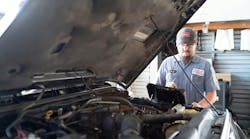Due to how costly comebacks events are for fleets, it is imperative to have the vehicle completely repaired the first time it is in the shop. If technicians do not detect all issues on the vehicle, fleets face additional downtime that can threaten on-time deliveries. If a technician fails to notice or fix an issue initially, the problem can fester and lead to a breakdown and/or a more expensive repair the second time the vehicle is in the shop, directly affecting the vehicle owner’s bottom line. Fortunately, many comebacks are preventable with the use of fault history.
The average fleet will want all active fault codes addressed while the vehicle is in the shop, but it is important to take note of certain inactive faults as well. A unique feature of JPRO Professional, the in-shop diagnostic and repair tool created by Noregon, is the counts provided to show users how many times a fault has occurred. After clicking on an inactive fault, if the "Launch Fault History" button is illuminated, that fault has occurred within the last two years and is a repeat issue. Technicians should then examine further and compare the previous count to the current count to help determine if the fault was not cleared, or if it is indicative of a looming problem.
Because not all faults that can disrupt a vehicle’s operations will illuminate a dash light, or even register as an active fault, it is crucial to pay attention to all the information JPRO provides. To illustrate this point, consider a vehicle with an inactive code indicating a potential issue with the heater blower motor. Using JPRO, the technician sees the inactive code with an associated count of 25. Noticing the illuminated "Launch Fault History" button, he or she learns that the same code had a count of 2 a few weeks prior. Understanding a high-count hints to a likely problem in the future, the technician consults with the vehicle owner and gets approval to make the repairs.
Now, imagine the same scenario above but with a technician only looking at active codes and not utilizing the vehicle’s fault history. Given that the motor did not trigger an active code or illuminate a dashboard lamp, that issue would remain ignored. The vehicle is sent back into transit, the blower motor fails, and after the windshield fogs up, the driver realizes there is no way to fix the issue. The driver must pull over to the side of the road and incur a tow cost, plus a potential missed delivery due to the unplanned downtime.
The benefits of examining inactive fault codes, the associated count, and the fault history have benefits for a fleet or owner-operator, but also creates opportunities for a service center to differentiate themselves from the competition and improve their profits. By finding all issues on the vehicle, service centers can upsell additional services to customers and gain their trust by discovering additional issues and communicating the potential effects to the customer.
Information provided by Noregon Systems, Inc.


